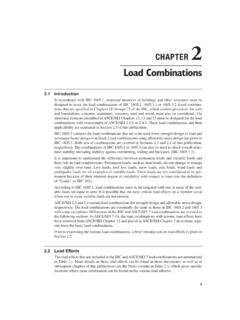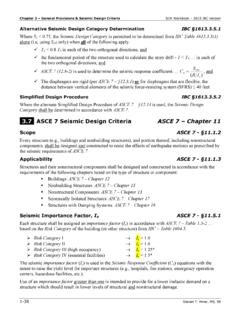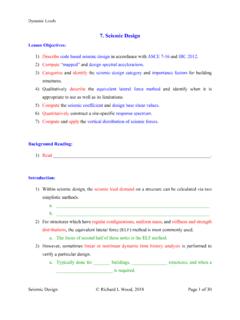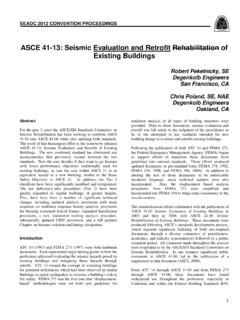Transcription of A Guide to Using ASCE 7-16 - RCASF
1 Copyright 2020 GAF 1 Campus Drive Parsippany, NJ 07054 A Guide to Using asce 7 -16 For EverGuard TPO/PVC Mechanically Attached and Drill-TecTM RhinoBond Roofing Systems Prepared by GAF Technical Services June 2020 Copyright 2020 GAF 1 Campus Drive Parsippany, NJ 07054 1 asce 7 -16 Guide Published 6/ 2020 Table of Contents Page Introduction 2 About GAF 2 asce 7 2 Important Considerations 3 Step-by-step Procedure Step 1 Determine the Applicable Building Code 4 Step 2 Locate Design Wind Uplift Pressures 4 Step 3 Identify the Design Method Used 5 Step 4 Apply a Safety Factor 5 Step 5 Select a Wind Rated Roofing System 5 Step 6 Determine the Wind Zone Layout 8 Rectangular Roof Plan Examples 9 Non-rectangular Roof Plan Examples 12 Courtyard Example
2 17 Roof Zone 1 18 Parapets 3 feet 18 Lookup Tables with and Calculations 18 Application Considerations for Roof Zones 2 and 3 22 Performance-based 22 Prescriptive enhancement 22 Conventional Mechanically Attached Roofing Systems 22 Method A: Standard Picture Framing 23 Method B: Partial Picture Framing 28 Method C: Standard Picture Framing with Supplemental Fastener Rows 33 Method D: Standard Picture Framing with Drill-TecTM RhinoBond Fastener Rows 36 Method E: Full Size Sheets and Drill-TecTM RhinoBond Fastener Rows 39 Method F: Full Size Sheets and Drill-TecTM RhinoBond Roofing System in Zones 2 and 3 42 Drill-TecTM RhinoBond Roofing Systems 43 Appendixes Appendix A: asce 7 Comparison 44 Appendix B.
3 FM 1-29 Prescriptive Enhancements for Perimeters and Corners 47 Copyright 2020 GAF 1 Campus Drive Parsippany, NJ 07054 2 asce 7 -16 Guide Published 6/2020 Introduction The purpose of this Guide is to provide fundamental information on code requirements, wind design, how to navigate asce 7 -16 when selecting appropriate roofing systems, and suggestions on roof system application. This Guide is limited to: 2016 edition of asce 7 , Minimum Design Loads and Associated Criteria for Buildings and Other Structures ( asce 7 -16). Buildings with roof slopes less than 7 degrees (approximately 1 :12 roof slope).
4 Building heights less than 60 ft. Mechanically attached and Drill-TecTM RhinoBond roofing systems. About GAF Founded in 1886, GAF is the largest roofing manufacturer in North America. As the industry leader, GAF proudly offers a comprehensive portfolio of award-winning, innovative roofing products for both steep-slope and commercial properties. Supported by an extensive national network of factory-certified contractors, GAF has built its reputation and its success on its steadfast commitment to Advanced Quality, Industry Expertise, and Solutions Made Simple. GAF offers all major low-slope roofing technologies, including repair and maintenance products and roof restoration systems, as well as new roofing systems (BUR, modified bitumen, TPO, PVC, and liquid-applied roofing membranes).
5 GAF has developed single-ply, asphaltic and liquid-applied membranes with excellent durability to meet the most rigorous industry standards. For more information, visit asce 7 asce 7 , Minimum Design Loads for Buildings and Other Structures ( asce 7 ) is a consensus standard developed and maintained by the American Society of Civil Engineers. It describes the means for determining dead, live, soil, flood, tsunami, snow, rain, atmospheric ice, earthquake, and wind loads, and their combinations for general structural design. Three editions of asce 7 are used in the , the 2005, 2010 and 2016. The 2016 edition has several significant changes that affect the wind design of roofing systems.
6 Roofing systems are considered Components and Cladding (C&C). The design procedures for C&C are located in Chapter 30, Wind Loads Components and Cladding (C&C). Copyright 2020 GAF 1 Campus Drive Parsippany, NJ 07054 3 asce 7 -16 Guide Published 6/ 2020 The following design parameters are used to determine design wind uplift pressures: Roof slope (must be less than 7 degrees) Building dimensions (width, length and height) Basic wind speed, V Risk Category (I, II, III or IV) Exposure coefficient (B, C or D) Topography factor, kzt Wind directionality factor, kd Ground elevation factor, ke There are some noteworthy differences between the three asce 7 editions and they include.
7 The wind speed maps, roof zones, enclosure classifications, external pressure coefficients, and the equation to calculate velocity pressures. See Appendix A for additional information on the differences between the 2005, 2010 and 2016 editions of asce 7 . Important Considerations GAF manufactures and sells roofing materials and does not practice architecture or engineering. GAF is not responsible for the performance of its products when damage to its products is caused by such things as improper building design, construction flaws, or defects in workmanship. The design responsibility remains with the architect, engineer, roofing contractor, or owner.
8 These guidelines should not be construed as being all-inclusive. Please consult your design professional for more information. The guidelines contained herein are for information purposes only, and are not intended as a substitute for independent evaluation by the building owner or its consultants to determine with certainty whether a particular roofing system is suitable for a building. GAF makes no representation or warranty (express or implied) as to the suitability of its roofing systems for buildings. Information contained in this Guide is presented in good faith and, to the best of GAF s knowledge, does not infringe upon any patents, foreign or domestic.
9 Copyright 2020 GAF 1 Campus Drive Parsippany, NJ 07054 4 asce 7 -16 Guide Published 6/2020 Step-by-step Procedure The following provides a step-by-step procedure for how to use design wind data to select appropriate roofing systems and help determine roof zone layouts as prescribed in asce 7 -16. Step 1 Determine the Applicable Building Code Determine which building code edition is applicable with the authority-having-jurisdiction. The applicable edition of asce 7 will vary by the edition of the International Building Code (IBC), see below: IBC Edition Applicable ASCE-7 Edition 2009 asce 7 -05 2012 asce 7 -10 2015 asce 7 -10 2018 asce 7 -16 Therefore, asce 7 -16 is applicable in municipalities that have adopted the 2018 IBC or where it has been adopted as a local ordinance or amendment.
10 Step 2 Locate Design Wind Uplift Pressures IBC requires wind design data be shown on the drawings and/or in the project specifications. Look for the following information which is required: Basic design wind speed, V, and allowable stress design wind speed, Vasd Risk Category Wind Exposure (wind direction) Applicable internal pressure coefficient Design wind uplift pressures Other items that should be addressed on the project documents include: Components and Claddings: asce 7 classifies roofing systems as Components and Cladding or C&C. Therefore, the design wind loads applicable for roofing systems will be labeled as Components and Cladding or C&C.





